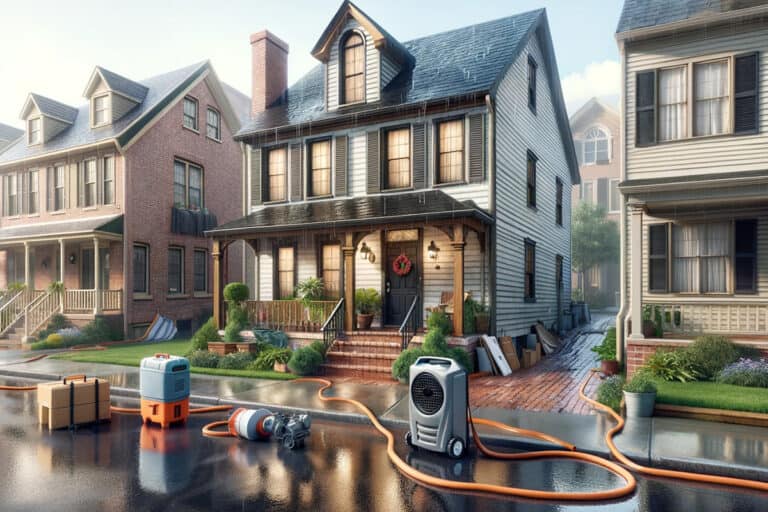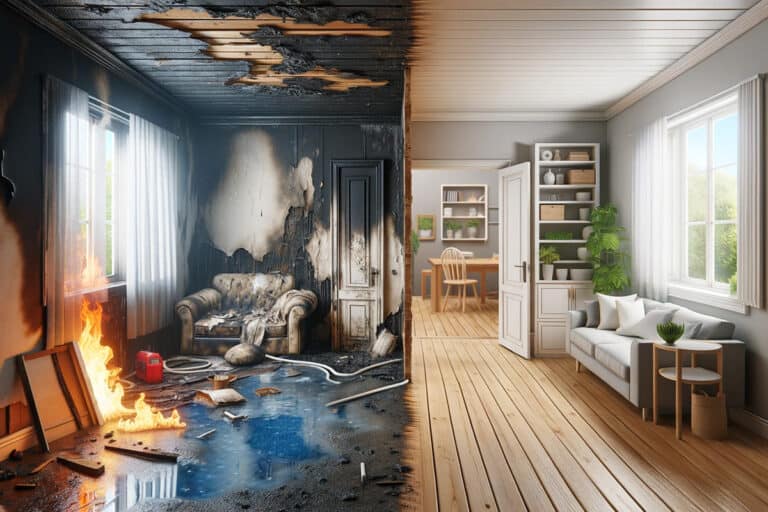Disclosure: I am compensated for purchases made through some links on this site. Click for details.
Leaking roofs can introduce unwanted moisture into your home, creating a breeding ground for mold. Left unaddressed, this combination can lead to systemic mold growth which compromises indoor air quality and risks structural damage. Understanding the relationship between leaks and mold is crucial for homeowners to maintain a healthy living environment.
Identifying mold growth resulting from roof leaks is the first step towards remediation. Early detection allows for more straightforward and cost-effective solutions, while delayed action often escalates to complex, expensive repairs. Domestic intervention can be effective for minor issues, but extensive mold infestation may require professional services.
Maintenance and regular inspections post-repair are essential to prevent recurrence. By addressing repairs promptly and understanding the moisture dynamics of your home, long-term prevention is achievable. This ongoing vigilance ensures the integrity and safety of your living space.
Key Takeaways
- Moisture from roof leaks can cause widespread mold growth in homes.
- Prompt detection and remediation of mold are key to limiting damage.
- Regular maintenance is crucial for preventing future mold issues related to leaks.
Understanding Roof Leaks and Mold
This section provides an in-depth look at the intricate relationship between roof leaks and mold, focusing on the causes, health implications, and the dynamic of moisture that facilitates mold growth in buildings.
Causes of Roof Leaks
Roof leaks often result from compromised roofing materials, which can be due to several factors such as aging shingles, broken tiles, or damaged flashing. Severe weather conditions like heavy rain, snow, and hail can exacerbate existing vulnerabilities, leading to a leaky roof that allows water infiltration into the interior spaces of a home.
Mold Growth and Health Risks
When moisture from a roof leak invades a building, it sets the perfect stage for mold growth. Mold spores, which are always in the air, will settle on damp surfaces and can start to multiply within 24 to 48 hours. The presence of mold can significantly decrease indoor air quality and pose health risks, especially causing respiratory problems in individuals with sensitivities or compromised immune systems.
Roof Leaks and Moisture Dynamics
The moisture dynamics in a building with a roof leak can lead to systemic growth of mold. Water damage from leaks increases humidity levels, supporting mold proliferation throughout the structure. This ongoing cycle of dampness not only supports the growth of existing mold but also aids the dispersion of mold spores, potentially affecting larger areas and causing more extensive damage.
Identifying Leaking Roof Mold
It is critical for homeowners to recognize the early indications of mold caused by roof leaks to mitigate damage. Accurate identification through various signs and thorough inspection can prevent extensive damage to both the structure and the inhabitants’ health.
Visual Inspection for Damage and Mold
A homeowner should start with a visual inspection for any evidence of damage or mold on their ceiling. Discoloration or water stains are usually the first sign. They should meticulously check their attic or the highest ceiling in their home, especially after a rainstorm, for signs like stains or visible mold growth.
Signs and Symptoms of Roof Mold
Symptoms of roof mold may include a distinct musty odor indicating mold’s presence, even if it is not visible. Homeowners should be vigilant about black mold, which often appears as dark spots or patches on ceilings or walls, signifying a more significant issue.
Warning Signs of a Leaking Roof
Warning signs include dampness on ceilings or walls and peeling paint, which is often coupled with a sagging appearance. It’s imperative to address these warning signs promptly, as prolonged exposure to moisture can severely damage a home’s structure and the health of those living within.
DIY vs. Professional Remediation
When tackling a leaking roof mold issue, homeowners must decide between embarking on a DIY project or enlisting the expertise of a professional. Considerations include the scope of mold growth, safety concerns, and the potential long-term effectiveness of the remediation.
When to Call a Professional
In the case of extensive mold growth or if the mold is caused by a significant roof leak, it may be wiser to contact a professional roofing contractor or a mold remediation specialist. These professionals have the necessary equipment and training to safely and effectively address mold issues. Homeowners should consider calling a professional especially when their health or the structure of their home is at risk.
Assessing DIY Mold Cleanup
Homeowners may opt for DIY mold remediation when the affected area is small and the mold is superficial. Individuals must use protective gear, such as masks and gloves, to minimize exposure to mold spores. However, they should understand that DIY methods might not always reach the root of the problem and thoroughness is key for a successful cleanup.
Steps to Address Leaking Roof and Mold
When addressing a leaking roof and mold, timely action is crucial. Homeowners should focus on immediate measures to contain any damage, thorough removal of mold, and effective repair and prevention strategies to ensure lasting protection against further issues.
Initial Measures for a Leaky Roof
Upon discovering roof leakage, the first step is to contain the water damage. Homeowners should place containers under drips and remove valuables from affected areas to minimize damage. To prevent accidents, create a clear area around the leak and consider temporarily covering the affected area with a waterproof tarp.
Mold Remediation Process
The presence of mold due to roof leaks demands immediate action. The affected area needs proper ventilation and the use of dehumidifiers to aid in moisture reduction; fungicides may be applied to halt mold growth. All contaminated materials should be removed and the affected surfaces thoroughly cleaned and sanitized according to recommended guidelines.
Related Content: How to Prepare for Mold Remediation: Steps for a Safe Process
Repairing and Preventing Roof Leaks
Long-term solutions require roof repair with an emphasis on sealing areas with high-grade caulk and replacing damaged shingles or other roofing materials. Ensuring proper ventilation, especially near vents, helps to keep the roof dry and reduces the likelihood of future leaks. Regular maintenance and inspection are key preventative measures to confidently manage roof integrity over time.
Factors Affecting Repair and Remediation
When addressing a leaking roof that has led to mold infestation, there are critical factors one must consider to manage repair and remediation effectively. These factors guide the approach to not only restoring the integrity of the roof but also ensuring a safe and healthy environment within the home.
Extent of Water and Mold Damage
The scope of water damage and subsequent mold growth significantly impacts the repair strategy. It is necessary to conduct a thorough assessment to determine the extent, which can range from minor leaks to major structural weakening. Typically, mold remediation becomes more intensive as the exposure time and area affected increase.
Choosing the Right Roofing Contractor
Selecting a roofing contractor is a decision that should not be taken lightly. Homeowners should look for licensed professionals with experience in both roofing repairs and mold remediation. A reputable contractor will not only provide high-quality workmanship but also advice on preventing future issues.
Costs and Insurance Considerations
The financial aspects of roof repair and mold remediation can be complex. Homeowners should review their insurance policy to understand coverage limits and whether damage from a leaking roof is included. Additionally, obtaining multiple bids ensures competitive pricing and better understanding of the necessary replacement or repair work.
Related Content:
- Does Insurance Cover Mold Removal: Understanding Your Policy
- How to Get Insurance to Pay for Water Damage
Maintaining Your Home Post-Repair
Post-repair maintenance is essential for safeguarding your home against future roof damage and mold issues. Homeowners should implement preventative measures and routine checks to ensure the longevity of roof repairs and the overall health of their home.
Preventative Measures for Roof Health
Ventilation: Proper ventilation in the attic is crucial. Homeowners should clear any blockages and consider adding additional vents if necessary to maintain airflow, as this helps to prevent excess moisture and heat build-up, which can damage roofing materials over time.
Gutters: Keeping gutters clean is fundamental to prevent water from pooling on the roof. It is recommended that homeowners inspect and clear their gutters at least twice a year to prevent clogs that can lead to water seeping under shingles.
Reducing Indoor Humidity and Mold Risks
Humidity Control: Maintaining low humidity levels inside the home is key in reducing the risk of mold growth. Use dehumidifiers and exhaust fans, especially in high moisture areas like bathrooms and kitchens, to keep indoor humidity levels between 30% and 60%.
Mold Inspection: After repair, frequent inspection for signs of mold in common areas such as basements, bathrooms, and around windows helps in early detection and prevention. Homeowners should be proactive in addressing any signs of mold immediately.
Routine Checks and Maintenance Tips
Regular Inspections: Homeowners should schedule regular inspections of their roof to identify and address potential issues early. Look for missing, damaged, or worn shingles and check for signs of water infiltration.
Maintenance Schedule: Create and adhere to a maintenance schedule. This includes tasks like checking for roof damage after severe weather, trimming tree branches that overhang the roof, and ensuring proper attic insulation to prevent ice dams.
By adhering to these focused practices, homeowners can significantly extend the life of their roof repairs and reduce the risk of mold growth in their homes.
Concluding Thoughts on Tackling Leaking Roof Mold
As this discussion draws to a close, it is clear that our best defense against leaking roofs and mold growth lies in being informed, vigilant, and proactive. The journey towards maintaining a mold-free, healthy home environment is marked by several key actions and commitments:
- Early Detection: Recognize the early signs of moisture intrusion. Early intervention simplifies the remediation process, making it less daunting and more cost-effective.
- Immediate Action: Address leaks and mold at the first sign of trouble. Prompt repairs can prevent the spread of mold and save on extensive future repairs.
- Long-Term Commitment: Adopt a routine of regular maintenance and preventative measures to safeguard the structural integrity of your home and the health of its occupants.
By incorporating these strategies, we transform the challenge of mold remediation from a formidable obstacle into a manageable aspect of home care:
- Regular Inspections: Schedule routine checks of your roof and home’s interior for signs of moisture or mold. This proactive approach helps catch potential issues before they escalate.
- Moisture Control: Maintain low indoor humidity levels (ideally between 30% and 60%) using dehumidifiers and exhaust fans. Proper ventilation in areas prone to moisture, like bathrooms and kitchens, is crucial.
- Preventative Maintenance: Keep gutters clean, ensure adequate attic ventilation, and repair any roof damage promptly to prevent water infiltration.
Creating a Safe Haven
Embracing these practices ensures that our living spaces remain safe, comfortable, and conducive to good health. It’s not just about property maintenance; it’s a commitment to the well-being of our families. Let’s stand united in our efforts to keep our homes dry, our air quality high, and our living environments free from the harmful effects of mold. Together, we can uphold the sanctity of our homes, making them true sanctuaries for our loved ones.




